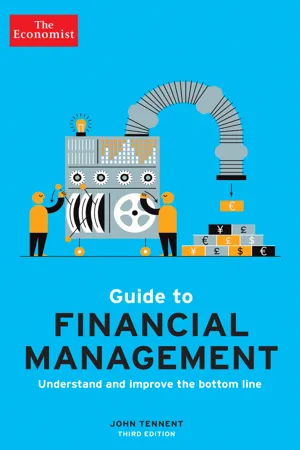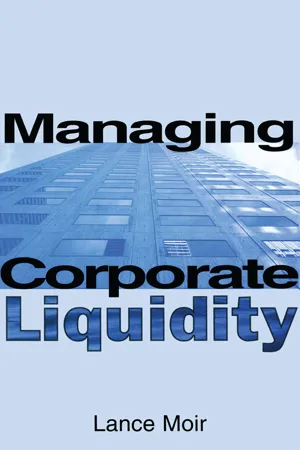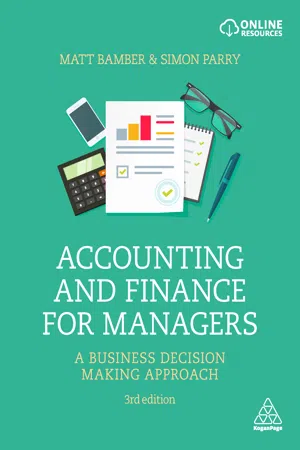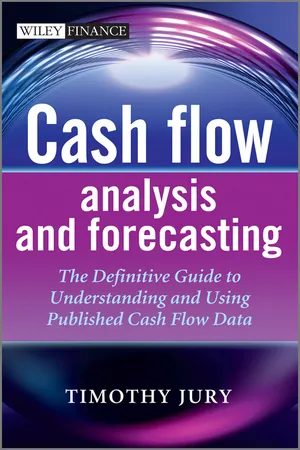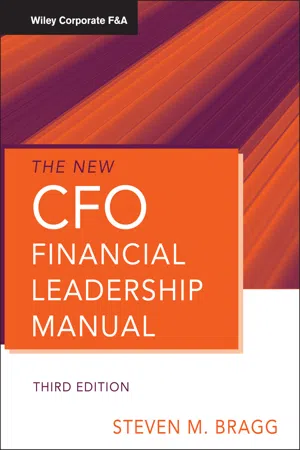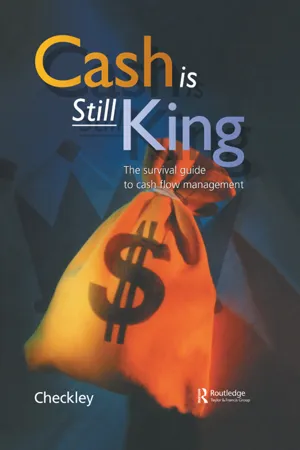Business
Cash Flow Forecast
A cash flow forecast is a financial tool used to predict the future inflows and outflows of cash within a business over a specific period. It helps businesses anticipate their financial position and plan for potential cash shortages or surpluses. By analyzing expected cash flows, businesses can make informed decisions about investments, expenses, and financing.
Written by Perlego with AI-assistance
Related key terms
Related key terms
1 of 4
Related key terms
1 of 3
11 Key excerpts on "Cash Flow Forecast"
- eBook - ePub
The Economist Guide to Cash Management
How to avoid a business credit crunch
- John Tennent(Author)
- 2012(Publication Date)
- Economist Books(Publisher)
Cash Flow ForecastingA BUSINESS HAS A RESPONSIBILITY to make payments when they are due regardless of whether sufficient cash has been collected from customers to provide the means of payment. Unpaid suppliers may be begrudgingly tolerant and wait a little longer for their cash, but they may refuse to fulfil further orders until payment is made and they may even take legal action to recover the debt.To enable management to plan appropriately and feel confident that payments can be made as they fall due, a detailed Cash Flow Forecast is required that predicts the timing and amounts of receipts and payments. The advance warning of any potential cash shortages that are revealed allows management the time to put together a considered, rather than reactive, plan for bridging any gaps in cash flow. It can take time to negotiate with banks and raise additional finance, and with a well-structured and realistic Cash Flow Forecast this can be done well in advance of any potential need.Furthermore, a well-constructed Cash Flow Forecast helps give banks and other providers of finance confidence in management realism and competence – and can encourage banks to lend at less onerous interest rates than they otherwise might.This chapter looks at the construction of the most important tool in managing cash and avoiding a cash crisis – a Cash Flow Forecast. It explains how this links to the business plan and how to manage anticipated cash surpluses or deficits.Cash Flow Forecasting
The essence of constructing a Cash Flow Forecast is to take the current cash balance and predict the likely receipts and payments that will arise within a set of time intervals. The quality of the predictions determines the quality of the Cash Flow Forecast and its usefulness. What the Cash Flow Forecast is to be used for – funding, operational or strategic purposes – will determine the time period and time intervals: - eBook - ePub
The Economist Guide to Financial Management 3rd Edition
Understand and improve the bottom line
- John Tennent(Author)
- 2018(Publication Date)
- Economist Books(Publisher)
13
Cash Flow Forecasting
A BUSINESS HAS A RESPONSIBILITY to make payments when they are due regardless of whether sufficient cash has been collected from customers to provide the means of payment. Unpaid suppliers may be begrudgingly tolerant and wait a little longer for their cash, but they may refuse to fulfil further orders until payment is made and they may even take legal action to recover the debt.To enable management to plan appropriately and feel confident that payments can be made as they fall due, a detailed Cash Flow Forecast is required that predicts the timing and amounts of receipts and payments. The advance warning of any potential cash shortages that are revealed allows management the time to put together a considered, rather than reactive, plan for bridging any gaps in cash flow. It can take time to negotiate with banks and raise additional finance, and with a well-structured and realistic Cash Flow Forecast this can be done well in advance of any potential need.Furthermore, a well-constructed Cash Flow Forecast helps give banks and other providers of finance confidence in management realism and competence – and can encourage banks to lend at less onerous interest rates than they otherwise might.This chapter looks at the construction of the most important tool in managing cash and avoiding a cash crisis – a Cash Flow Forecast. It explains how this links to the business plan – for how to manage anticipated cash surpluses or deficits, see Chapter 7 .Cash Flow Forecasting
The essence of constructing a Cash Flow Forecast is to take the current cash balance and predict the likely receipts and payments that will arise within a set of time intervals. The quality of the predictions determines the quality of the Cash Flow Forecast and its usefulness. What the Cash Flow Forecast is to be used for – funding, operational or strategic purposes – will determine the time period and time intervals: - eBook - ePub
- Lance Moir(Author)
- 2014(Publication Date)
- Routledge(Publisher)
Note that there is a deliberate split between short term and long term items. The purpose of this is to identify how much cash the business is generating or consuming from day-to-day activities. Many external lenders and investors in group situations will expect the trading cash flow to be able to fund new capital expenditure and dividend payments. If the trading cash flow is negative then this may point to an unsustainable business or one which is consuming too much cash in working capital (alternatively, this may be part of a deliberate business strategy for a growing business). This format will allow the treasurer to make pertinent comments to his or her colleagues about the cash flow of the business.As with the receipts and payments method, the basic forecast can be prepared at business-unit level, therefore it may be useful to introduce lines for inter-company payments.Different businesses will have different concepts of profit. It will be useful to try to express the true underlying level of profit by excluding non-recurring items such as profit on property sales and extraordinary and exceptional items. These frequently include non-cash elements which obviously do not form part of a cash forecast. For cash elements, it is better to show these separately in the bottom half of the forecast.When calculating the movements in the components of working capital, careful separation of any unusual elements such as a debtor due an uncompleted property sale will allow a better understanding of what is actually going on as well as helping to calculate the business cash flow.For all other elements, the need is to concentrate on the cash which is actually going to flow in the period under consideration. Virtually all of these items should be generated by a normal management accounts package. - eBook - ePub
The 30 Day MBA in Business Finance
Your Fast Track Guide to Business Success
- Colin Barrow(Author)
- 2016(Publication Date)
- Kogan Page(Publisher)
There is a saying in business that profit is vanity and cash flow is sanity. Both are necessary, but in the short term, and often that is all that matters in business as it struggles to get a foothold in the shifting sands of trading, cash flow is life or death. The rules on what constitutes cash are very simple – it has to be just that, or negotiable securities designated as being as good as cash.FIGURE 1.1 A simple system of keeping business recordsCash flow is looked at in two distinct and important ways: as a projection of future expected cash flows, and as an analysis of where cash came from and went to in an accounting period and the resultant increase or decrease in cash available.Cash Flow Forecasts
The future is impossible to predict with great accuracy but it is possible to anticipate likely outcomes and be prepared to deal with events by building in a margin of safety. The starting point for making a projection is to make some assumptions about what you want to achieve and testing those for reasonableness.Take the situation of High Note, a business being established to sell sheet music, small instruments and music CDs to schools and colleges, which will expect trade credit and members of the public who will pay cash. The owner plans to invest £10,000 and to borrow £10,000 from a bank on a long-term basis. The business will require £11,500 for fixtures and fittings. A further £1,000 will be needed for a computer, software and a printer. That should leave around £7,500 to meet immediate trading expenses such as buying in stock and spending £1,500 on initial advertising. Hopefully customer’s payments will start to come in quickly to cover other expenses such as some wages for bookkeeping, administration and fulfilling orders. Sales in the first six months are expected to be £60,000 based on negotiations already in hand, plus some cash sales that always seem to turn up. The rule of thumb in the industry seems to be that stock is marked up by 100 per cent, so £30,000 of bought in goods sell on for £60,000. - eBook - ePub
Accounting and Finance for Managers
A Business Decision Making Approach
- Matt Bamber, Simon Parry(Authors)
- 2020(Publication Date)
- Kogan Page(Publisher)
Now that you have learnt how to produce a simple cash-flow forecast, we will look at a more complex example and learn how to analyse and interpret it. Within larger organizations it will usually be the case that cash-flow forecasts are produced by the accounting department. As a manager you will be using that forecast to make both operational and strategic decisions.Expert view 7.5: Cash-flow forecastingLarge organizations usually have a specialist division within the accounting department that is dedicated to cash planning and cash-flow forecasting. This is usually known as the treasury department.Worked Example 7.9 sets out a cash-flow forecast for the start-up of a new business. We will take a detailed look at this forecast and identify any potential problems which may be looming for the business. We will also identify any changes to business plans that could be recommended in order to improve the business’s cash flow and cash position.WORKED EXAMPLE 7.9 Cash-flow analysisJill has recently been made redundant from her job as a designer. She has decided to use her redundancy money to realize her dream of starting a business which manufactures and sells high-quality greenhouses. In order to start the business Jill has applied for a business start-up loan from the bank. The bank requires a business plan, which includes a cash-flow forecast. Jill has prepared the cash budget for the first six months of the business (Table 7.4 ).In relation to the cash budget, Jill has provided you with the following information:- The business will commence on 1 June with $55,000 in the bank. $30,000 of this will come from Jill’s redundancy money. The remaining $25,000 will come from a business start-up loan.
- Jill will rent a workshop unit on an industrial estate. This will cost $900 per month, payable at the start of each month.
- A van will be bought in June at a cost of $12,000.
- General workshop costs (light, heat, power etc) and the van’s running costs are expected to be $400 per month.
Table 7.4Skip table - eBook - ePub
Cash Flow Analysis and Forecasting
The Definitive Guide to Understanding and Using Published Cash Flow Data
- Timothy Jury(Author)
- 2012(Publication Date)
- Wiley(Publisher)
plausible. Forecasts are not right or wrong as such, because they are not based on scientific fact, they are simply plausible. In other words, they represent what we think is more or most likely to happen in the future, rather than some other less likely scenario. A single forecast is subject to the laws of probability, it represents one probable future. There are always other parallel probable futures.So, taken even more literally, plausible means we like this forecast more than any other forecast. This, then, is a subjective judgment; it is more plausible to us. In other words prejudice and opinion are also a factor to consider in the process of preparing and using forecasts.The term future scenarios is more self-explanatory. Let me repeat this because it is so important: forecasts are not right or wrong as such. In order to create a forecast it is necessary to make certain assumptions about the future. The forecast itself, which consists of apparently factual numbers with the same authority as any other accounting information, is actually nothing more than a scenario based on the particular set of assumptions used to make it. It is neither right nor wrong. It follows from this that much of the difficulty in forecasting arises from the assumptions we make and the way we use them in our forecast model. A forecast does not represent fact (what will happen), it represents what might happen, given a particular set of circumstances (the assumptions).REASONS FOR PREPARING Cash Flow ForecastS Why do we prepare Cash Flow Forecasts? The usual reason for doing this is to assist with some sort of decision making in the present. The preparation of a Cash Flow Forecast starts with its purpose. What is the forecast for? Typical reasons for preparing forecasts of a businesses cash flow are:- Do we have enough cash to run our business next month, quarter, year?
- Do we have enough cash to buy, invest in X?
- When do we think we will we get paid by our customers?
- Can we afford to pay for asset X?
- How do we pay for asset X?
- How much should we invest in project X?
- How much do we think business X is worth?
In order to assist us in making these decisions it may be helpful to create one or more forecasts of the expected cash inflows and outflows relevant to the decision. In other words, the purpose of the forecast should dictate the scope - eBook - ePub
- Steven M. Bragg(Author)
- 2010(Publication Date)
- Wiley(Publisher)
An experienced compiler of cash forecasts will consider a number of variables when constructing a forecast. For example, employee expense reports tend to arrive at the end of the month, and so will be paid during the first week of the following month. Also, the accounts payable departments of many companies operate with reduced staffing near major holidays, and so are less likely to issue payments on their usual schedules; this is a particular problem during the Christmas holidays. Similarly, payroll payments will be shifted forward in time if a company holiday is scheduled for what would otherwise have been a payroll day. For these reasons, cash forecasting requires a considerable amount of experience.Measuring Cash Forecast AccuracyA cash forecast is useless unless it can be relied on to yield accurate forecasts. There are a number of ways to improve the forecast, all involving the continuing comparison of past forecasts to actual results and correcting the system to ensure that better information is provided for future forecasts.A key area in which the cash forecast can be wildly incorrect is in receipts from sales forecasts. A detailed review of this area will reveal that some salespersons do not want to forecast any sales, because then they will be held accountable for their predictions. This problem requires constant feedback with the sales staff to correct, and may require reinforcement by including the sales forecasting function in the annual review and compensation plan for them.Another problem is in the accounts payable area, where actual cash outflows will typically exceed forecast cash outflows. This imbalance is caused by a faulty accounts payable data entry process, whereby invoices are initially mailed by suppliers to people outside of the accounts payable department, or because invoices are sent out for approval before they are logged into the accounting system, thereby resulting in their late appearance in the forecast, usually just before they need to be paid. These problems can be solved by asking suppliers to send invoices straight to the accounting department, and by entering all invoices into the accounting system before sending them out for approval. It is also possible to review open purchase orders to see if there are any missing invoices that are supposed to be currently payable, thereby proactively starting a search for the missing invoices. - Michael Chibili(Author)
- 2019(Publication Date)
- Routledge(Publisher)
5The cash flow statement (also called the statement of cash flow)
5.1 Cash in the business5.2 Establishing cash flow statements5.3 A worked example in the establishment of the SCF using the indirect methodCompanies can only survive if they have enough cash in hand to be able to take care of all their expenses. Cash is considered as the lifeblood of any business. Users of financial statements who assess only the statement of profit and loss to try and determine the financial health of the company might later on realize that their assessment may have been incorrect. Profitable companies have been known to have suddenly failed because they did not adequately manage their cash flows. An understanding of the importance and management of cash is a must if any company’s management would want to avoid sudden liquidity problems. Section 5.1 discusses the place of cash in a business, while at the same time differentiating profits from cash. Section 5.2 provides the rules in the establishment of the cash flow statement, while Section 5.3 is a worked example of the cash flow statement using one of the well established methods.5.1 Cash in the business
Cash is money, in the form of notes and coins, which constitutes payment for goods or services at the time of their purchase or consumption. Cash is not only cash in hand but also deposits and overdrafts which are commonly called cash equivalents. All transactions whether they are settled immediately or settled in the future are ultimately conducted by cash or cash equivalents. Just like all other assets, cash is an asset with the same properties like other assets, and also many more. The structure of the subsections is as follows:- eBook - ePub
- Bev Vickerstaff, Parminder Johal(Authors)
- 2014(Publication Date)
- Routledge(Publisher)
Cash flow statements 8‘In thebusinessworld, everyone is paid in two coins:cashand experience. Take the experience first; the cash will come later’. (HARQLD S. GENEEN )CHAPTER OUTLINE8.1 Introduction8.2 The importance of cash8.3 Cash versus profit8.4 Purpose of the cash flow statement8.5 Presentation of the cash flow statement8.6 Interpreting cash flow statements8.7 Cash flow budgets8.8 SummaryAfter carefully reading the text and completing the tasks and activities provided in this chapter you should have a better understanding and knowledge of:CHAPTER OBJECTIVES• the difference between cash and profit• the layout and structure of the cash flow statement• how to identify the cash inflow and cash outflow items that make up the cash flow statement• the preparation of a basic cash flow statement• how a cash flow statement can be used to aid decision making• the ways in which a cash budget differs from a cash flow statement.8.1 Introduction The cash flow statement is the third key financial statement that companies quoted on the stock exchange are required to produce, the other two being the statement of financial position and the income statement, which you looked at in Chapters 3 and 4 .This chapter seeks to focus on the cash inflows and cash outflows that make up the cash flow statement. It is evident from both television and newspaper reports just how important a role cash plays in a company. At the time of writing (September 2011), the economic climate of the last three years has resulted in companies collapsing at an alarming rate. The reason for these collapses is quite simple – the companies concerned did not have sufficient cash to carry on trading. Before we continue we need to define what we mean by cash.KEY TERMCash - eBook - ePub
- Keith Checkley(Author)
- 2012(Publication Date)
- Routledge(Publisher)
1 CASH FLOW AND BUSINESS
Cash flows are normally reported in a Cash Flow Statement . In the United Kingdom this is prepared in accordance with Financial Reporting Standard (FRS) No. 1 - Cash Flow Statements. In countries that have adopted international accounting standards it is prepared in accordance with International Accounting Standard (IAS) No. 7 - Cash flow Statements. The Cash Flow Statement is a relatively recent phenomenon. FRS 1 was issued in the United Kingdom in September 1991. IAS 7, having originally been called Statement of Changes in Financial Position, was revised in 1992 and retitled Cash Flow Statements. Prior to this the UK and many other countries required a Statement of Source and Application of Funds in the annual accounts which, while being a document that assisted in the analysis of cash flows, was not a cash flow statement and proved difficult to interpret.Ever since the joint stock company was invented in the 1800s it has been customary to offer shareholders an annual Profit and Loss Account and Balance Sheet. However, professional analysts have realized that cash flows are essentially a matter of fact and are therefore much less prone to accounting interpretation by managers and directors of companies. Consequently we are now seeing much more emphasis being placed on the identification and analysis of cash flows as opposed to the traditional approach of data derived from the Profit and Loss Account and Balance SheetSee overleaf for extract from FRS 1 - Illustrative exampleXYZ LIMITEDNote to the cash flow statement
Reconciliation of operating profit to net cash inflow from operating activities:1. Net cash inflow from operating activities
The identification starts with operating profit, and the next two items are depreciation and the (profit)/loss on sale of fixed assets, which are added back. The objective is to identify the cash generated from operations . This is normally achieved by adding back to operating profit all non-cash items - eBook - ePub
Corporate Valuation
Measuring the Value of Companies in Turbulent Times
- Mario Massari, Gianfranco Gianfrate, Laura Zanetti(Authors)
- 2016(Publication Date)
- Wiley(Publisher)
The value of the FCFE depends not only on the incidence of interest and income taxes but also on the change in the net financial position. Therefore, the projections set forth by the expert for the company's valuation need to include a limit (or a target) for the firm's financial structure. This is an important specification that draws attention to the fact that the cash flow to shareholders depends on the future financing operation choices involving the use of debt.5.6 BUSINESS PLAN AND CASH FLOW PROJECTIONS
The structure and consistency of a business plan's assumptions determine the quality of the plan itself and of the whole valuation process. Therefore, it is of paramount importance to validate the assumptions used with the most accurate data and information available.5.6.1 The Basic Assumptions
The projections of the firm's results, which are relevant for a firm valuation, are often (but not necessarily) derived from several provisional financial statements that are based on a system of basic assumptions (in the international jargon: valuation assumptions).Since the setup of multiyear financial statements and flows is a technical procedure, the quality of the estimate exclusively depends on how sensible and consistent the valuation assumptions are with respect to the company's reality. Moreover, the valuation's disclosure and reliability always depend on how clearly the basic assumptions have been introduced and explained. It is useful to distinguish three categories of assumptions:- Assumptions on the general and financial economic environment. Depending on the specific needs of the estimate, they include factors such as:
- GDP growth rate
- Evolution of consumption (of final goods or investment)
- Exchange rates
- Interest rates
- Expected inflation rate
- Assumptions regarding the company's industry or the project that is being valued. Taking into consideration the specific needs of the estimate, they include factors such as:
- Growth rate of the market (or niche) where the company is competing
- Competitors' strategies
Index pages curate the most relevant extracts from our library of academic textbooks. They’ve been created using an in-house natural language model (NLM), each adding context and meaning to key research topics.
Explore more topic indexes
Explore more topic indexes
1 of 6
Explore more topic indexes
1 of 4

